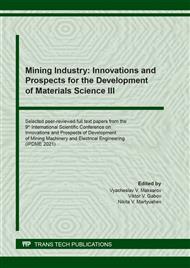p.13
p.21
p.28
p.41
p.48
p.54
p.60
p.70
p.76
Using the Method of Measuring the Microhardness of Different Zones of Welded Joints to Assess the Strength Properties
Abstract:
Corrosion-resistant steels with a high nitrogen content are used as structural materials for high-load critical products. Their high strength and ductility, austenite stability, corrosion and wear resistance are highly relevant for parts and structures operating in marine environments. In addition to a high level of operational properties, they are subject to the requirement of manufacturability, including weldability. Welding of such steels, due to the high concentration of nitrogen, is a complex technological operation, and it is necessary to avoid the appearance of gas nitrogen pores, hot cracks, a sharp drop in mechanical properties in any zones of welded joint. In this work, we investigated the regularities of changes in microhardness in different zones of welded joints (base metal, heat-affected zone of the weld, fusion zone and weld metal) of two grades of austenitic Cr-Ni-Mn-Mo-N high-strength steels with a high equilibrium nitrogen content (up to 0.6%). They fundamentally differ in the structural state of the base metal being welded: deformed (hot-rolled sheet) and cast (metal of a heat-treated cast plate). It has been shown that despite the use of different welding methods (MIG, MMA and TIG), the options for welding fillers and the type of weld groove, there are general patterns for each of the two types of base metal. The work also evaluated the correlation between these regularities and such basic characteristics of the structure and properties of rolled and cast metal of welded joints, such as the grain size and values of the yield stress.
Info:
Periodical:
Pages:
48-53
Citation:
Online since:
February 2022
Authors:
Price:
Сopyright:
© 2022 Trans Tech Publications Ltd. All Rights Reserved
Share:
Citation:


